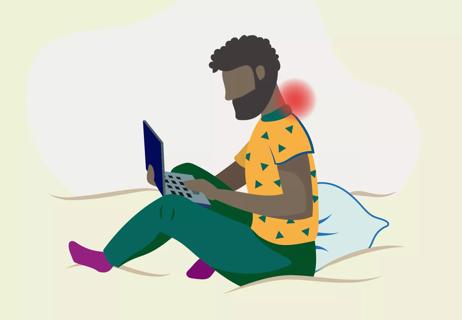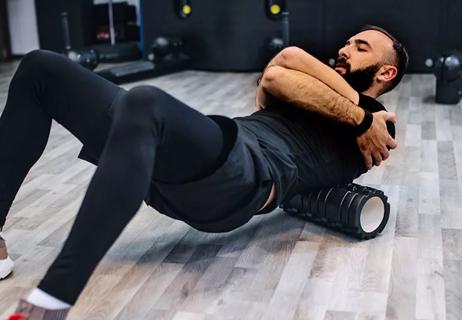Neck problems can lead to head pain, but relief is possible

A headache has a relentless ability to ruin your day. Sometimes, we can blame our pounding head on stress, sinus problems or a migraine. But what if your headache has nothing to do with your head?
Advertisement
Cleveland Clinic is a non-profit academic medical center. Advertising on our site helps support our mission. We do not endorse non-Cleveland Clinic products or services. Policy
A cervicogenic headache isn’t your typical headache, explains headache and pain specialist Emad Estemalik, MD. It’s a neck problem that translates into head pain. Doctors call it referred pain — when you feel pain in a different area of your body other than the source of the problem.
Dr. Estemalik explains what you should know about a cervicogenic headache — and warning signs you shouldn’t ignore.
If you’ve ever experienced a headache after whiplash, you might have had a cervicogenic headache. Other causes include:
Cervicogenic headaches have some unique traits that may clue you in. “Cervicogenic headaches usually hurt on one side of the head,” Dr. Estemalik says. “They start around the base of your skull and radiate up one side.”
Your neck may also give you some hints. “A hallmark of a cervicogenic headache is a limited ability to move your neck or head,” Dr. Estemalik explains. “Your headache may get worse when you move your neck.”
A major injury like a fall or accident isn’t the only trigger for these headaches. If your desk or office chair causes you to slouch or strain, you could get a cervicogenic headache.
Advertisement
“When you sit at a desk too long, you may have your neck flexed down,” Dr. Estemalik says. “You might arch your back while you’re sitting. This can bring on a cervicogenic headache.”
Look into proper ergonomics for your office if you sit at a desk. “Focus on keeping your back and neck straight while you sit,” says Dr. Estemalik. “Make sure you’re not bending forward.”
“Some patients get relief from cervicogenic headaches after getting a massage,” Dr. Estemalik says. “A massage therapist can relieve tension in muscles that are causing the headache.”
See a professionally trained massage therapist who has experience dealing with neck pain. Ask your doctor for recommendations.
Sleep should be a time for your body to rest and recharge. So be choosy about your sleeping equipment.
“Finding the right mattress and pillow can be key to preventing a cervicogenic headache,” Dr. Estemalik says. “Do you wake up with neck pain or a headache? That could be a clue that you need to switch your pillow or mattress.”
Find a pillow that keeps your neck in line with your back. The exact pillow type varies from person to person based on your sleeping position and body type. And follow Goldilocks’ advice about your bed: Not too hard or too soft. Replace old mattresses and pillows, since they lose their support after years of use.
If you strained your neck, it’s tempting to try and do some stretching or exercises yourself. But DIY treatment may not be helpful and could make it worse.
“The neck is very complex,” Dr. Estemalik says. “That’s why physical therapy is key to treating this type of headache. Your physical therapist can identify which muscles are involved. They can guide you through exercises to strengthen the core muscles that need it. They also help you avoid overusing certain muscles that could cause more pain.”
Without expert guidance, you could further strain your neck or work on the wrong areas.
Even if you have classic symptoms of a cervicogenic headache, don’t pop some pain reliever and forget about it. See a doctor, who can rule out something more serious.
“Always take a one-sided headache seriously,” says Dr. Estemalik. Although rare, it can be a sign of a tear in one of the neck arteries. This is a common cause of stroke, especially in people under age 45.
If you notice any of these signs with a headache, seek emergency care right away:
Most cervicogenic headaches get better with physical therapy and pain relievers. In some cases, a minimally invasive pain relief procedure such as a nerve block can be helpful.
Advertisement
You have options for relief, so don’t try to tough it out. See your doctor to find out how to get rid of the pain and get back to living your life ASAP.
Advertisement
Learn more about our editorial process.
Advertisement

You can relieve this condition by improving your posture and using a variety of movements

Ease pain and stay active by keeping your spine in its proper position

Get the answer along with tips for safe installation

Here’s why it may be happening and how you can find some relief

Stretching or applying heat and ice can provide pain relief

Foam tubes and rubber balls can help when you hurt

Here’s how working from bed impacts your health

Avoid discomfort with the proper workstation

Type 2 diabetes isn’t inevitable with these dietary changes

Applying a hot or cold compress can help with pain